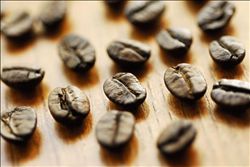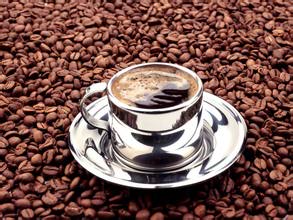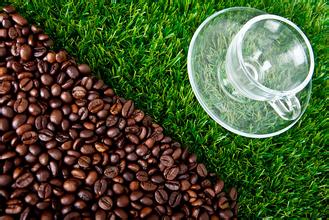Coffee Culture: coffee knowledge Literacy
Classification of coffee: coffee, small evergreen trees or shrubs, rubiaceae, long ovate leaves, pointed front, white flowers, berries, crimson, with two semilunar seeds together, and some oval seeds fried into powder, which can be used as a beverage, exciting and cheap stomach, produced in tropical and subtropical regions.
In terms of varieties, there are two main types: Arabica coffee (Coffea Arabica) and Robbite coffee (Coffea Robusta), the former accounting for 70% of the world's total output, the latter 30%. The main difference between the two is that Arabica coffee suffers from "rust" while Robster does not. Arabica coffee is hardy and grows in an area of 15-24 °C, while Robster is 24-29 °C, and the growth requirements are not as strict as the former. For example, it is OK to be below 500 meters above sea level, and the requirement of rainfall is not so strict.
The Jamaican Blue Mountain Coffee and Mocha Coffee that we are familiar with are named from the venue or the port of export, because generally speaking, the quality of the coffee exported from the previous coffee, a place, or a port is relatively consistent. It will be different from that in other places. This can represent the taste and quality of a kind of coffee. In fact, a place of origin can not guarantee the quality of coffee, and there are different varieties of coffee often produced in one place. For example, Cameron produces Arabica coffee and Robster coffee at the same time, but it is traditionally divided in this way. the world-famous coffee we are talking about now usually refers to a certain kind of coffee. Coffee celebrities in this way are:
Jamaican Blue Mountain Coffee (Jamaican BlueMoutain), which can be sold at the most expensive price in the world. The taste is very subtle, the acidity is just right, the taste is fresh and elegant, with a hint of sweetness and excellent mellow, very smooth and refreshing, and an unparalleled aroma. Suitable for medium baking, so that the original flavor can be preserved to a large extent. * is its main consumer.
Hawaiian Kona Coffee (Hawaii Kona) is fresh, crisp, medium-bodied, slightly sour and full-bodied, with a long finish and a blend of wine, fruit and spice aromas. Suitable for light or moderate baking.
Brazil Bourbon Santos (Brazil Bourbon Santos) Brazil is the largest coffee-growing country in the world. Coffee drinking is common, but it is low-grade coffee. Because the altitude of his country is generally low, and it is planted in a large area, manual harvest is difficult to implement, generally mechanical harvest, so ripe and green fruits will be mixed together, affecting the quality. Generally speaking, Brazilian bourbon Santos coffee has no outstanding advantages, but there are no obvious defects. This coffee has a mild and lubricated taste, low acidity, moderate mellow, light sweetness, and is suitable for popular methods. It is the best raw material for making Italian espresso and all kinds of fancy coffee. Suitable for ordinary baking.
Columbia Super Coffee (Columbian Supremo), a unique location, at the foot of the Andes (Andes), mild climate and humid air, no frost, undulating mountains provide a diversified climate and long growth cycle, resulting in its small particles, mellow taste. This coffee is medium mellow, low acidity, sweet, has the best flavor and delightful aroma. Some people say that Colombian super coffee has the strong lubrication characteristic of Sumatra Mantenin, a special walnut bitterness and nutty taste, suitable for medium roasting.
Harald, Ethiopia (Ethiopian Harrar), which has a mixed flavor, has a mellow taste, moderate or mild acidity, and the lowest caffeine content because residents still pick wild coffee, making it the most unusual and special coffee in the world. Its dry treatment gives it a unique earthy smell, and its unique primitive wild flavor is very aggressive. Suitable for shallow baking.
Kenya A.A because it is very similar to Yemeni mocha and Ethiopia, they both have a chic wine taste and a long aftertaste, but it is rare that Kenyan coffee has the mellow and smooth taste that Ethiopian coffee and Yemeni coffee do not have. it is lighter than Ethiopian coffee and more mellow than Yemeni mocha, so it is generally suitable for deep roasting.
Yemeni mocha coffee. One of the oldest coffee in the world, Yemen is at the southernmost tip of the Arabian Peninsula, and Mocha is a port in Yemen where coffee was formerly named. But now the port of Mocha no longer exists and has become a sandbar. The mocha coffee we are talking about now generally refers to coffee of similar quality, which has lost the meaning that he began to name. Nowadays, coffee in Arabian Peninsula is called mocha coffee, and sometimes Harald coffee produced in Ethiopia is also called mocha. It is characterized by fruity, obvious wine, spicy and nutty flavors. Some people also commented that the aftertaste of mocha is very similar to that of blueberries, with a strong sour taste and obvious chocolate flavor, which is suitable for deep baking, and it is said that it is best to grind and brew after baking for a day or two.
Unlike Central American coffee Sumatra Mandheling, which is dry and long, it is characterized by mellow taste, mild acidity and long-lasting flavor. Although not as mellow as the fresh vanilla wine of African coffee beans, Indonesian coffee beans are known as "sweet herbal flavors" and are suitable for medium roasting.
What is said above is from the classification of coffee beans, what we hear every day is the name of fancy coffee. Here are some common coffees.
Italian espresso (Espresso), coffee is very strong, made from long-roasted coffee beans, usually requires 7 grams of coffee powder and 40-65 milliliters of water. This is the "raw material" for making a lot of fancy coffee.
Cappuccino: half a cup of Espresso and half a cup of foamy milk. Sprinkle the milk with cocoa or cinnamon powder to decorate or prevent the milk from peeling.
Latte (Latte) is not so much coffee as milk. Latte is also Espresso coffee made with milk, but it contains more milk than cappuccino.

Important Notice :
前街咖啡 FrontStreet Coffee has moved to new addredd:
FrontStreet Coffee Address: 315,Donghua East Road,GuangZhou
Tel:020 38364473
- Prev

Why are Koreans so successful in opening cafes?
Did the Koreans really get the true biography of the coffee god? How many secrets did you get? Today, let's share how successful the cafe for Shenma Koreans is: the common caf é factions on the market: European coffee shops represented by French and Italian coffee: special emphasis on the quality and taste of coffee beans. Summed up in a recent popular sentence is: a small private shop with craftsman spirit.
- Next

Introduction to the characteristics of various coffee beans-Brazil
Brazilian coffee bean origin: Brazil Brazil baking method: City Roast grade or variety: NO.2/sc-19 coffee bean characteristics: 1. Palate: slightly bitter and sour, mild in nature. two。 Fragrance: light and elegant, the fragrance is in the middle. 3. Vision: beans with large particles, light green or yellowish beans brief description: a world's largest coffee producer and exporter, which can be called the "coffee continent".
Related
- Does Rose Summer choose Blue, Green or Red? Detailed explanation of Rose Summer Coffee plots and Classification in Panamanian Jade Manor
- What is the difference between the origin, producing area, processing plant, cooperative and manor of coffee beans?
- How fine does the espresso powder fit? how to grind the espresso?
- Sca coffee roasting degree color card coffee roasting degree 8 roasting color values what do you mean?
- The practice of lattes: how to make lattes at home
- Introduction to Indonesian Fine Coffee beans-- Java Coffee producing area of Indonesian Arabica Coffee
- How much will the flavor of light and medium roasted rose summer be expressed? What baking level is rose summer suitable for?
- Introduction to the characteristics of washing, sun-drying or wet-planing coffee commonly used in Mantenin, Indonesia
- Price characteristics of Arabica Coffee Bean Starbucks introduction to Manning Coffee Bean Taste producing area Variety Manor
- What is the authentic Yega flavor? What are the flavor characteristics of the really excellent Yejasuffi coffee beans?

